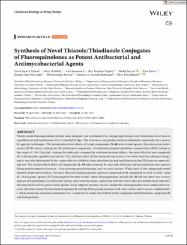Synthesis of novel thiazole/thiadiazole conjugates of fluoroquinolones as potent antibacterial and antimycobacterial agents

View/
Date
2025Author
Poyraz Yılmaz, PınarKulabaş, Necla
Bozdeveci, Arif
Vagolu, Siva Krishna
Imran, Mohd
Tatar, Esra
Alpay Karaoğlu, Şengül
Sriram, Dharmarajan
Mahmood, Ammar A. Razzak
Küçükgüzel, İlkay
Metadata
Show full item recordCitation
Poyraz Yılmaz P, Kulabaş N, Bozdeveci A, Vagolu SK, Imran M, Tatar E, Alpay Karaoğlu Ş, Sriram D, Mahmood AAR, Küçükgüzel İ. Synthesis of Novel Thiazole/Thiadiazole Conjugates of Fluoroquinolones as Potent Antibacterial and Antimycobacterial Agents. Chem Biol Drug Des. 2025 May;105(5):e70126.Abstract
Twenty azole-fluoroquinolone hybrids were designed and synthesized by conjugating thiazole and thiadiazole structures to
ciprofloxacin and norfloxacin via a 2-oxoethyl bridge. The structures and purities of the synthesized compounds were proven
by spectral techniques. The antimycobacterial effects of target compounds 21–40 were tested against Mycobacterium tuber culosis H37Rv strain. Among the 20 synthesized compounds, 12 exhibited minimal inhibition concentration (MIC) values in
the range of 1.56–25 μg/mL. Among the molecules screened for antimycobacterial effects, the most effective was compound
35, a thiadiazole-ciprofloxacin hybrid. The cytotoxic effect of this molecule was found to be lower than the reference drugs,
and it was also determined to be a more effective inhibitor than ciprofloxacin and norfloxacin in the DNA-gyrase supercoil ing test. The antimicrobial effects of compounds 21–40 were screened by agar-well diffusion and microdilution tests against
Gram-positive/negative bacteria, a fast-growing mycobacterium, and two yeast strains. While most of the compounds tested
showed antibacterial effects, the most effective fluoroquinolone derivative appeared to be compound 31 with an MIC value
of < 0.63 μg/mL against all Gram-negative bacteria tested. Azole-fluoroquinolone hybrids 21–40 did not show any activity
against non-pathogenic Lactobacillus species and yeast-like fungi, indicating that they have selective antibacterial and anti mycobacterial activity, particularly against Gram-negative bacteria. In silico molecular docking studies were conducted to un cover the interactions between lead compound 35 and the DNA gyrase proteins of M. tuberculosis and S. aureus. Additionally,
a 100ns molecular dynamics simulation was carried out to assess the stability of the complexes formed between compound 35
and both proteins.
Source
Chemical Biology and Drug DesignVolume
105Issue
5URI
https://onlinelibrary.wiley.com/doi/10.1111/cbdd.70126https://pubmed.ncbi.nlm.nih.gov/40415348/
https://doi.org/10.1111/cbdd.70126
https://hdl.handle.net/20.500.12780/1146

















